|
|
 |

|
 |
 |
Air Traffic Management Technology Demonstration 1 (ATD-1)
Airspace Technology Demonstration 2 (ATD-2)
Crew Activity Tracking System (CATS)
CTAS-FMS Integration, 2002 (CFI'02)
Distributed Air Ground Traffic Management (DAG-TM)
Functional Allocation
High Density Vertiplex (HDV)
Integrated Demand Management (IDM)
Multi-Sector Planner
New York Operational Improvements
OASIS
SOAR
Unmanned Aircraft System (UAS) Traffic Management (UTM)
Air Traffic Management Technology Demonstration 1 (ATD-1):
Interval Management - Terminal Area Precision Scheduling and Spacing (IM-TAPSS)

ATD-1 technologies have enabled arrival aircraft to safely fly closer together on more fuel-efficient routes to increase capacity, reduce delay, and minimize emissions.
Today's National Airspace
At any given moment, up to 5,000 aircraft crowd U.S. skies. In 2010, the National Airspace System (NAS) managed the progress of nearly 10 million flights. Such high air traffic demand, operating with procedures that were largely in place from the earliest days of commercial aviation, does not always result in the most efficient or coordinated operations. As a result, the air transportation system often experiences significant delays and lost productivity, and produces greater amounts of noise pollution, carbon dioxide, and other greenhouse gas emissions than if operations were more efficient. As air traffic demand is projected to double in the next 20 years, our current air traffic control system will be further strained and the environment adversely affected.
Improving the efficiency of the terminal area, which is the volume of airspace surrounding airports to a radius of about 50 miles, is an especially complex task due to operating characteristics that are quite distinct from the en route environment. Terminal area controllers manage both ascending and descending aircraft, more frequent turns, a wider range of separation standards, as well as terrain and increased traffic density within shorter time horizons.
In today’s terminal area arrival operations, as an aircraft transitions for landing, controllers track and guide the aircraft from cruise altitude to the runway using simple visual aids as well as their skills and judgment. They issue turn-by-turn instructions (a process known as vectoring) via radio communications. As aircraft approach the runways, controllers manually merge aircraft and sequence them for arrival. Busy terminal area conditions often force the aircraft to fly inefficient arrival paths involving frequent changes in direction, altitude, and speed to maintain safe separation from other aircraft. Frequently, controllers must employ longer routes (known as path stretching) or holding patterns to tactically accommodate larger amounts of delay.
The tactical nature of this manual approach leads to increased fuel burn and noise pollution, contributes to high controller workload, and exacerbates traffic congestion. Moreover, the imprecision of this current system creates greater uncertainty, and forces controllers to add buffers to the separation required between aircraft, which decreases airspace capacity, leading to further delays.
While more efficient arrival paths are achievable today, current technology limits their feasibility to only during light traffic conditions, such as during the middle of the night. During periods of high-density traffic, maintaining safe separation and throughput take precedence over achieving efficient operations. The technical challenge facing the aviation community is to make efficient arrival procedures common practice during heavy traffic when they are needed most, while still ensuring safety and throughput.
NextGen: The Airspace System of the Future
NASA collaborated with the FAA and other industry partners to develop several advanced automation tools that provide air traffic controllers, pilots, and other airspace users with more accurate real-time information about the nation’s traffic flow, weather, and routing. The greater precision of this information is a key enabler of the Next Generation Air Transportation System (referred to as NextGen). NextGen is a comprehensive transformation of the NAS, which will be safer, more reliable and more efficient, and will reduce the impact of aviation on the environment. The transition to NextGen is vital to improving system performance, meeting continued growth in air traffic, and increasing the Nation’s mobility to support economic progress. ATM Technology Demonstration-1 (ATD-1) showcased an integrated set of NextGen technologies that provided an efficient arrival solution for managing aircraft beginning from just prior to top-of-descent and continuing down to the runway.
These technologies are:
- Automatic Dependent Surveillance – Broadcast (ADS-B)
- Area Navigation (RNAV) Arrival Routes
- Optimized Profile Descent (OPD) Procedures
- Terminal Metering
- Flight Deck Interval Management (FIM)
- Controller Managed Spacing (CMS) tools
These ATM technologies have all been tested separately and each has demonstrated throughput, delay, and/or fuel-efficiency benefits. Together, the technologies demonstrated the feasibility of high throughput of efficient arrival operations during peak traffic conditions in the terminal area. Simply put, the integration of these terminal arrival tools will allow arrival aircraft to safely fly closer together on more fuel-efficient routes to increase capacity, reduce delay, and minimize fuel burn, noise, and greenhouse gas emissions.
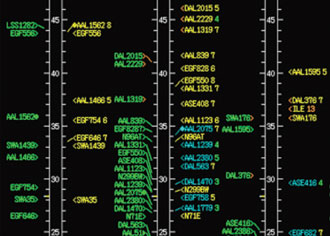
The Traffic Management Advisor (TMA) will determine an arrival schedule along advanced RNAV arrival routes for safe, orderly, and expeditious flow of traffic in the terminal area.
Using the ATD-1 technologies, both pilots and controllers have more accurate and timely information and advisories, thus reducing the need for extensive coordination and negotiation between them to achieve more efficient operations. Terminal Metering (based on precision scheduling enhancements to the Traffic Management Advisor [TMA]) determines an arrival schedule based on airport conditions, airport capacity, required spacing, and weather conditions and utilizes new, more direct RNAV routes that extend from en route airspace and continue through terminal airspace to the runway. The schedule, determined well in advance of when it is executed, is communicated to both controllers and flight crews. Flight crews will know their intended flight path, which aircraft they ought to be following, and the desired spacing interval at certain points along their designated RNAV route to reach the destination airport safely and on schedule. Controllers will no longer have to make tactical, last second decisions concerning merges and arrival slots, and will not likely need to provide as many interventions as they do in today’s busy traffic conditions.

Flight Deck Interval Management (FIM) tools aboard the aircraft will enable flight crews to precisely space their aircraft relative to others to achieve ideal spacing.
To achieve the precise schedule set by TMA, some flight decks will be equipped with sophisticated onboard avionics. Flight Deck Interval Management (FIM) tools will provide guidance to pilots on whether to speed up or slow down to precisely merge and space their aircraft relative to others. The FIM tools will calculate speed advisories using information provided by ADS-B technology aboard the aircraft that is more accurate than traditional radar. Flight crews will be able to make finer adjustments to their speed and react more quickly to achieve ideal spacing. The tighter control enabled by FIM will reduce excess spacing buffers and result in higher terminal throughput.
NextGen will leverage the ADS-B infrastructure currently being implemented by the FAA. ADS-B uses a Global Positioning Satellite (GPS) System receiver aboard the aircraft to determine that aircraft's exact position. The ADS-B system combines the position data with the aircraft's identifier, course, speed, and altitude, then continuously broadcasts the information to other ADS-B equipped aircraft flying in the area. The information is also broadcast to a network of ADS-B ground stations, which in turn feed controller displays and other air traffic control technologies. ADS-B information provides greater situational awareness to flight crews and allows spacing responsibility to be shifted from the ground to the air, alleviating controller workload.
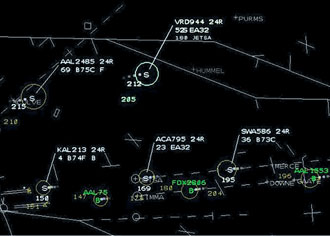
Controller Managed Spacing (CMS) tools will provide controllers with the information needed to properly space all aircraft (including those not equipped with FIM) to meet terminal metering schedules.
For aircraft not equipped with FIM and ADS-B technologies in the mid-term, new Controller Managed Spacing (CMS) decision support tools will provide controllers with the information needed to properly space aircraft to meet terminal metering schedules created by TMA. CMS display enhancements will indicate to the controller where an aircraft is scheduled to be along its RNAV route, and will calculate the speed advisories needed to maintain this schedule.
Optimized Profile Descent (OPD) Procedures allow aircraft to fly a continuous, gliding descent at low engine power. Contrary to today’s typical "dive and drive" procedures in which aircraft fly powered constant-altitude segments in a step-down fashion, OPDs are considered "green descents" because they reduce fuel consumption, environmental emissions, and noise pollution. Decision support tools will synchronize the descents of all arrival aircraft and advise controllers of the RNAV route and speed profile needed so that each can maintain an efficient descent and remain properly separated from preceding and following aircraft. OPD enhancements will make green descents possible during more traffic conditions, even heavy congestion, all while satisfying terminal metering schedules and achieving precise in-trail spacing to maximize terminal throughput.
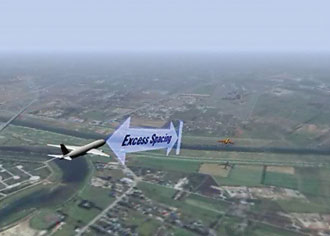
The higher precision achieved by ATD-1 technologies will reduce the size of excess spacing buffers, resulting in higher terminal throughput and capacity.
The more orderly, precise, and direct traffic flow enabled by the ATD-1 technologies will make the National Airspace System more predictable overall. This will allow airspace users to better respond to unexpected delays caused by convective weather and other airspace constraints. Instead of tactically absorbing delay close to the airport, where it is traditionally handled using path stretching and holding patterns, subtle variations in speed will be applied from cruise altitude to landing to distribute small amounts of delay over a longer portion of the flight. Strategically absorbing delay in this way relieves congestion that would normally build up near the airport, further increasing the efficiency of terminal area traffic flows.
Next Steps to Achieving NextGen
ADS-B will serve as the future surveillance source for the NAS. To further the widespread implementation of ADS-B, the Aviation Rulemaking Committee has recommended that demonstrations, such as ATD-1, should be used to help both government and industry evaluate potential benefits and costs of such implementation, as well as to understand the necessary equipment standards, aircraft certification guidance, and operational approvals. NASA teamed with the FAA and other industry partners in 2014-2015 to demonstrate the capabilities of integrated terminal area scheduling in an operational field trial. The goals of the field demonstration were to validate the benefits of the terminal area integrated arrival solution, system interoperability, and requirements for technology transfer.
The first phase of demonstration activities involved development of prototype systems, integration of all of the technologies, and initial human-in-the-loop simulations in NASA laboratories. The next phase involved development of the demonstration systems, follow-on simulations using FAA facilities and personnel, flight testing of avionics, and shadow testing of the integrated system. The last phase will finalized the demonstration plans and culminated in a field trial in a controlled, yet realistic operational environment at a major U.S. airport.
ATD-1 was a truly collaborative endeavor between government and industry. It involved the support, cooperation, and financial commitment of NASA and the FAA, as well as key industry and commercial aviation partners. NASA foundational research and technologies in terminal area scheduling, controller decision support tools, and flight deck automation actively leveraged the FAA's NextGen infrastructure. The participation of airspace users, avionics and aircraft manufacturers, and system integrators enabled these integrated terminal area ATM technologies to be evaluated in an operational environment. The demonstration is a major step in NASA's NextGen research and development process, and it brings us one step closer to realizing the air transportation system of the future.
For more information on ATM Technology Demonstration-1, please visit https://www.aviationsystems.arc.nasa.gov.
Benefits of ATD-1's Integrated Terminal Area Scheduling Technologies:
- System Benefits
- More efficient handling of delay
- Reduced excess spacing buffers
- Increased throughput
- More orderly flow of terminal area traffic
- Better predictability
- Decreased controller workload
- User Benefits
- Fewer delays
- Greater fuel-efficiency
- Increased use of advanced RNAV arrival procedures
- Environmental Benefits
- Fewer greenhouse gas emissions
- Less noise pollution
- Economic Benefits
- Increased mobility to support economic progress
Points of Contact: Todd Callantine, Ph.D., San Jose State University, Human Systems Integration Division, NASA Ames Research Center; Joey Mercer, M.S., Human Systems Integration Division, NASA Ames Research Center
Airspace Technology Demonstration 2 (ATD-2):
The AOL is participating in a multi-lab effort and a field evaluation of the integration of a number of tools that comprise the Airspace Technology Demonstration 2 (ATD-2) system. ATD-2 is an ambitious NASA project which, in collaboration with the Federal Aviation Administration (FAA), air carriers, airports, and the general aviation community, aims to integrate multiple concepts and technologies to enable integrated arrival, departures, and surface (IADS) operations in a metroplex environment. The AOL’s role is specialized in evaluating airspace solutions and human factors from an operational stand-point. ATD-2 aims to improve the predictability and the operational efficiency of the air traffic system in metroplex environments through the enhancement, development and integration of the nation’s most advanced and sophisticated arrival, departure and surface prediction, scheduling and management systems. For more information on ATD-2, please visit- https://aviationsystems.arc.nasa.gov/research/atd2/index.shtml.
In recognition of the many important contributions made by the roughly 150 members of the project team, NASA selected Airspace Technology Demonstration 2 as the 2021 NASA Software of the Year Runner-up.

Illustration showing multiple ATD-2 arrival, departure and surface operations concepts in a multi-airport environment.
To learn more about AOL contributions to ATD-2, please feel free to review the following publications.
Chevalley, E., Juro, G. L., Bakowski, D. L., Robeson, I., Chen, L. X., Coupe, W. J., Jung, Y. C., & Capps, R. A. (2020). NASA ATD-2 Trajectory Option Set Prototype Capability for Rerouting Departures in Metroplex Airspace. Paper presented at the 2020 IEEE/AIAA 39th Digital Avionics Systems Conference (DASC), Virtual Conference, October 11–16, 2020.
Parke, B. K., Bakowski, D. L., Verma, S. A., Chevalley, E., Jung, J. C.,Martin, L. H., Jobe, K. K., & Stevens, L. K. S. (2020). Impact of ATD-2 Tools on Human Factor Metrics at Charlotte Douglas International Airport. In 2020 AIAA/IEEE 39th Digital Avionics Systems Conference (DASC) (pp. 1-10). IEEE.
Lee, H. , Coupe, W. J, Jung, Y. C, Stevens, L. K, Parke, B. K,. & Bakowski, D. L. (2020). Objective Measurement Assessment of Departure Advisories for Ramp Controllers from a Human-In-The-Loop Simulation. IAIAA Aviation Forum, Virtual Event, June 15–19, 2020. https://doi.org/10.2514/6.2020-3204.
Parke, B. K, Bakowski, D. L, Jung, Y. C, Lee, H. , Coupe, W. J, & Stevens, L. K. (2020). Human Factors Impact of Different Ramp Controller Scheduling Advisories for ATD-2 Surface Metering in a Human-in-the-Loop Simulation. Paper presented virtually at the 2020 AIAA Aviation Forum, June 15-19.
Zhu, Z., Hosagrahara V. A., Lee, H., Jung, Y. C. & Bakowski, D. L. (2020). Impact of General Aviation Operations on Airport Performance Through Fast-Time Simulations at Charlotte-Douglas International Airport. AIAA Aviation Forum, Virtual Event, June 15-19, 2020. https://doi.org/10.2514/6.2020-2916.
Bakowski, D. L., Parke, B. K., & Goodyear, M. T. (2020). ATD-2 Metroplex Planner User Manual. Airspace Technology Demonstration (ATD-2) Project.
Bakowski, D. L., Parke, B. K., Freedman, C. J., & Goodyear, M. T. (2020). Ramp Traffic Console (RTC) and Ramp Manager Traffic Console (RMTC) User Manual. Airspace Technology Demonstration (ATD-2) Project.
Ruszkowski, L. K. M., Remple, R. K., Parke, B. K., & Bakowski, D. L. (2020).Surface Trajectory-Based Operations (STBO) Client User Manual. Airspace Technology Demonstration (ATD-2) Project.
Ruszkowski, L. K. M., Parke, B. K., Robeson, I. J., Goodyear, M. T., & Bakowski, D. L. (2020). Web-Based Surface Metering Display (SMD) User Manual. Airspace Technology Demonstration (ATD-2) Project.
Parke, B. K.,, Stevens, L. K. S., Coupe, W. J., Lee, H., Jung, J. C., Bakowski, D. L., & Jobe, K. K. (2019). Alternatives for Scheduling Departures for Efficient Surface Metering in ATD-2: Exploration in a Human-in-the-Loop Simulation. Paper presented at the 10th International Conference on Applied Human Factors and Ergonomics, Washington, D. C..
Parke, B. K, Jobe, K. K, Chevalley, E. , Verma, S. Dulchinos, V. & Stevens, L. K. (2018). Impact of data exchange provided by ATD2 tools at Charlotte-Douglas International Airport. Paper presented at the 9th International Conference on Applied Human Factors and Ergonomics, Orlando, Florida.
Verma, S. , Hanbong, L. , Martin, L. H, Stevens, L. K, Jung, Y. , Dulchinos, V. , Chevalley, E. , Jobe, K. K,. & Parke, B. K. (2017). Evaluation of a tactical surface metering tool for Charlotte Douglas International Airport via Human-in-the-Loop Simulation. Proceedings of the 36th Digital Avionics Systems Conference (DASC), St. Petersburg, Florida: IEEE/AIAA.
Stevens, L. K, Martin, L. H, Jobe, K. K, Parke, B. K, Chevalley, E. , Lee, H. , Verma, S. & Dulchinos, V. (2017). Evaluation of Approval Request/Call for Release coordination procedures for Charlotte Douglas International Airport. Proceedings of the 36th Digital Avionics Systems Conference (DASC), St. Petersburg, Florida: IEEE/AIAA.
Points of Contact: Joey Mercer, M.S., Human Systems Integration Division, NASA Ames Research Center; Eric Chevalley, Ph.D., Human Systems Integration Division, NASA Ames Research Center
Crew Activity Tracking System (CATS):
The Crew Activity Tracking System (CATS) was developed to track human operator activities in order to detect deviations from correct operations that may impact the safety of complex systems. It supports visualization and analysis of operator-caused deviations and the context surrounding them. CATS has a computational hierarchical model of the preferred way to control the system. With data about the current state of the system and constraints on its behavior, CATS generates a representation of the current operational context and predicts operator activities according to its model. CATS compares each actual operator action it detects to its predictions to determine if the action is: (1) preferable according to the model, (2) part of a valid alternative method for performing a required function, or (3) an error of commission. CATS also ensures that human operators perform activities to meet high-level control requirements; if not, CATS signals errors of omission. In addition to tracking operator activities, CATS also provides a framework for intelligent agents that can control simulated complex systems in predictable ways to support design.
CTA2 (CFI'02):
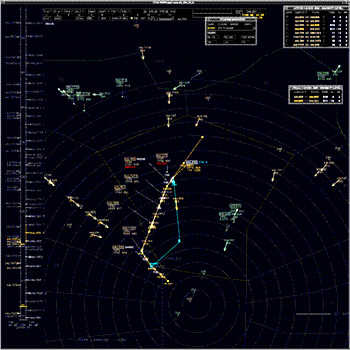 CFI'02 compared a sector-oriented approach to arrival flow management to a candidate trajectory-oriented approach. The sector-oriented approach was based on the existing 2002 operations for handling arrival traffic in a time-based metering situation. The trajectory-oriented approach provided advanced tools for the controller and introduced a more active interaction with the traffic management coordinator (TMC). These additions helped to manage an arrival flow from a broader perspective, helping controllers, especially controllers in upstream sectors, to use strategic clearances to improve the downstream flow at the meter fix merge. CFI'02 compared a sector-oriented approach to arrival flow management to a candidate trajectory-oriented approach. The sector-oriented approach was based on the existing 2002 operations for handling arrival traffic in a time-based metering situation. The trajectory-oriented approach provided advanced tools for the controller and introduced a more active interaction with the traffic management coordinator (TMC). These additions helped to manage an arrival flow from a broader perspective, helping controllers, especially controllers in upstream sectors, to use strategic clearances to improve the downstream flow at the meter fix merge.
CFI'02 sought to validate the assumed benefits associated with a trajectory-oriented approach. This research was conducted in two operational modes. The first was a baseline condition resembling current day operations for time-based metering. The trajectory-oriented approach was the other condition, adding such tools as CTAS/FMS descent procedures, conflict prediction, trial planning, speed advisories, automation to support controller-controller clearance coordination, and TMA-derived meter fix RTA advisory updates to en route aircraft.
The CFI'02 experiment gave us an opportunity to determine what benefits could be gained by introducing ground-based procedures for trajectory-oriented traffic management, and to develop scenarios and metrics to support other DAG-TM concepts.
Distributed Air Ground Traffic Management (DAG-TM):S-FMS Integration, 200
The Distributed Air/Ground Traffic Management (DAG-TM) concept is a coherent set of conceptual elements that describes possible modes of operation within the outlines of the Free Flight concept defined by the RTCA Task Force. It was originally conceived as one possible approach to the potential implementation of Free Flight, progressing along the path started by the Free Flight Phase 1 activities. This DAG-TM concept was developed by the Advanced Air Transportation Technologies (AATT) Project.
Distributed Air/Ground Traffic Management is a National Airspace System concept in which flight deck (FD) crews, air traffic service providers (ATSP) and aeronautical operational control (AOC) facilities used distributed decision-making to enable user preferences and increase system capacity, while meeting air traffic management requirements. DAG-TM was originally created with a human-centered operational paradigm enabled by procedural and technological innovations. These innovations included automation aids, information sharing and Communication, Navigation, and Surveillance (CNS) / Air Traffic Management (ATM) technologies.
DAG-TM was proposed for gate-to-gate NAS operations beyond the year 2015. It addressed dynamic NAS constraints such as bad weather, Special Use Airspace (SUA) and arrival metering/spacing. The goal of DAG-TM was to enhance user flexibility/efficiency and increase system capacity, without adversely affecting system safety or restricting user accessibility to the NAS. The DAG-TM concept was intended to address all user classes (commercial carriers, general aviation, etc.) with an emphasis towards ensuring access to airspace resources for the entire user community. It covered all flight phases (Pre-Flight Planning, Departure, Cruise and Arrival) and operational domains in the NAS (Surface, Terminal Airspace and En route Airspace). Although other operational domains (e.g., European, oceanic, and under-developed airspace) were outside the scope of the DAG-TM concept, consideration was always given to global interoperability issues.
Functional Allocation:
In conjunction with NASA Langley Research Center, NASA's Airspace Operations Lab explored issues and ideas for allocating separation assurance functions to meet the future air transportation needs. A separation assurance system primarily performs the functions necessary to ensure that aircraft remain safely separated from other traffic. Such a system is also simultaneously concerned with the avoidance of severe weather, the conformance of flights to a variety of operational constraints, and the overall expeditious flow of traffic from origin to destination. In the current system, air traffic services provide these functions. However even with the current level of operations, this can result in excessive controller workload, limited capacity and, often, inefficient operations. With an expected increase in traffic, these weaknesses can be exacerbated. New automation in the air, on the ground and/or the cloud, and powerful new communication technologies have enabled different ways to allocate trajectory management and separation assurance functions.
NASA’s function allocation research successfully identified the strengths and weakness of different allocations of separation assurance functions amongst the wide variety of agents participating in the air traffic operation. This research helped provide a roadmap to ensure that fundamental research is pointed towards an efficient final state. The future system has helped handle growing travel in a safe, efficient, and sustainable manner.
Points of Contact: Joey Mercer, M.S., Human Systems Integration Division, NASA Ames Research Center
High Density Vertiplex (HDV):
The High Density Vertiplex (HDV) subproject is responsible for the development and evaluation of a reference automation architecture that addresses scalable and efficient aircraft operations, flight and airspace management procedures, and vertiport operations in high density vertiplex environments.
HDV is a sub-project of the Advanced Air Mobility (AAM) project under the Integrated Aviation Systems Program (IASP).
What is a Vertiplex?
A Vertiplex is a geographic area that includes multiple vertiports whose arrival and departure operations are highly interdependent.
Purpose and Research Approach
The purpose of this research is to design concepts, procedures, and technologies focused on Urban Air Mobility (UAM) operations in a vertiplex environment. The HDV approach will be to gradually build-up complexity in the operational environment through a series of tests. Testing will be performed subscale using small Unmanned Aerial Systems (sUAS) as surrogates for UAM aircraft. Testing cycles will start out fully simulated, then culminate in live flight tests with small UAS at Langley Research Center. Results from each testing cycle will be used to support subsequent risk assessments. The overall goal is to create a representative UAM system to mitigate risk for future research and development.
Concepts Being Explored
Aircraft-airspace-vertiport automation technology must be integrated and matured to support three main use cases: (1) automated landing, (2) automated merging and spacing, and (3) automated contingency decision making.
Role of the AOL in HDV
During simulations and flights tests, the Airspace Operations Laboratory (AOL) and the Autonomous Vehicle Applications Laboratory (AVAL) will serve as the base of operations for Airspace Systems Integration (ASI), which integrates systems and software from Unmanned Aerial Systems (UAS) Traffic Management (UTM) to support HDV concepts. Some of the outcomes of this work include prototype airspace management automation technology and human factors evaluation.
Joining the AOL in the HDV flight testing efforts are the Autonomous Vehicle Applications Laboratory (AVAL) from the NASA Ames' Human Systems Integration Division, and the Air Traffic Operations Laboratory (ATOL) from Langley Research Center.
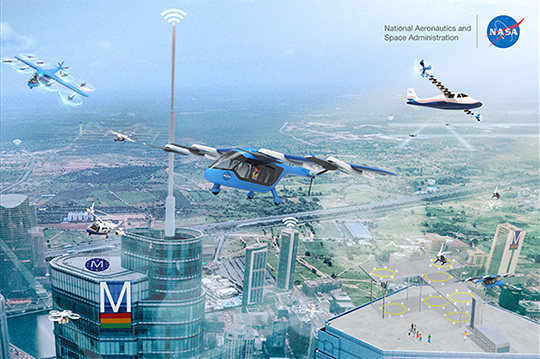
Illustration of Urban Air Mobility (UAM) Operations in a High Density Vertiplex (HDV) environment
Point of Contact: Gita Hodell, M.A., Human Systems Integration Division, NASA Ames Research Center
Integrated Demand Management (IDM):
AOL researchers recently led development of the Integrated Demand Management concept for operational integration of two of the FAA's NextGen decision support systems to improve capacity-constrained arrival operations in the National Airspace System (NAS). The AOL's HITL simulation platform was used to engage stakeholders in the development and evaluation of new methods and procedures for using Traffic Flow Management System (TFMS) initiatives to strategically precondition traffic for the more tactical Time-Based Flow Management (TBFM) system (FAA TBFM overview video). This preconditioning was shown in a series of realistic HITLs to improve the efficiency and predictability of TBFM operations and provide airline operators more control over individual flight outcomes when weather- or traffic-related congestion affected operations.
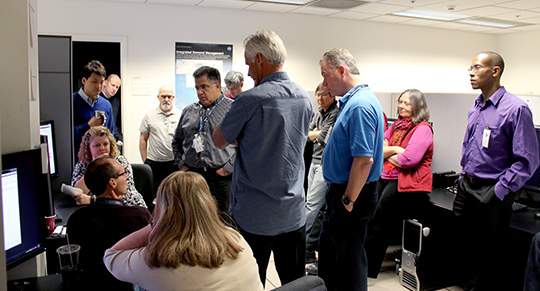
Traffic Flow Management System (TFMS) Deployment Team and representatives from MITRE Corp and MIT Lincoln Labs participate in IDM demonstration in the AOL.
Why IDM?
TFMS and TBFM represent two powerful NextGen automation systems used to address demand/capacity imbalances in the NAS. Recent enhancements to TBFM that extend its geographic and temporal range have introduced some overlap with TFMS functionality, raising the question of which system to use in some situations. TFMS features such as its collaborative decision making framework and new Collaborative Trajectory Options Program (CTOP) (FAA CTOP overview video) and Trajectory Option Set (TOS) capabilities, however, are absent from TBFM. Integrated Demand Management (IDM) proposes that often the best solution can be found by leveraging the complementary features of both systems, developing coordinated strategic (TFMS) + tactical (TBFM) flow management interventions as needed.
IDM Concept
IDM uses a strategic Traffic Management Initiative (TMI), such as CTOP, to adjust the rate and/or geographic distribution across arrival flows of the traffic inbound to a high-demand, TBFM-managed airport. This TFMS intervention preconditions the traffic before it reaches the TBFM planning horizon. This results in a more workable problem for TBFM, which can then tactically fine-tune the demand to deliver a well-managed, orderly feed to the destination airport. Coordinated use of these two flow management capabilities is intended to improve system performance in terms of:
- Equity of ground delay assignment, avoiding excessive ground delay for TBFM-scheduled departures, without penalizing longer flights;
- Throughput, by distributing traffic to maximize use of available capacity;
- Predictability for operators, providing advance notice about the impact on individual flights;
- Increased flexibility, by supporting operator mitigation strategies such as slot swapping and trajectory options;
- Efficiency of flight operations, by improving access to user-preferred routes, using ground delay more effectively, and reducing airborne delay.
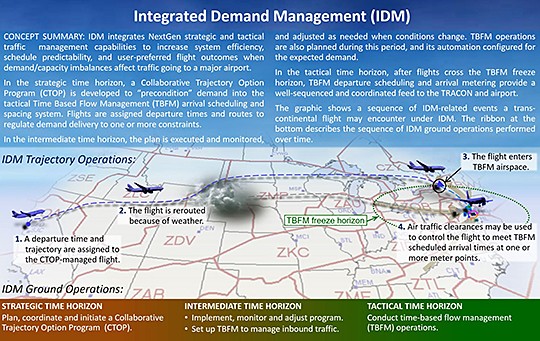
Concept summary, from Integrated Demand Management (IDM) Concept Overview.
Research Products
The AOL's IDM research was a stakeholder-centered, laboratory-based development process that provided the following products to the FAA.
- An IDM Concept and Procedures document and IDM Concept Overview slides that describe its context of use and the operational procedures for planning, coordination and execution of IDM operations in today's NAS.
- A description of CTOP User Interface Enhancements that were developed in the course of IDM HITL evaluations and demonstrations. While some of these were designed to support IDM-specific tasks, most were improvements that stakeholders found valuable for CTOP in general.
- A description of the IDM Flow Balancing Algorithm (FBA). The FBA was an algorithm that traffic managers could use to support design of an IDM CTOP that improved the distribution of inbound traffic across multiple arrival flows.
- An IDM Annotated Bibliography that provided an overview of the research publications conducted or supported by NASA under IDM, including links to all of the NASA-produced publications.
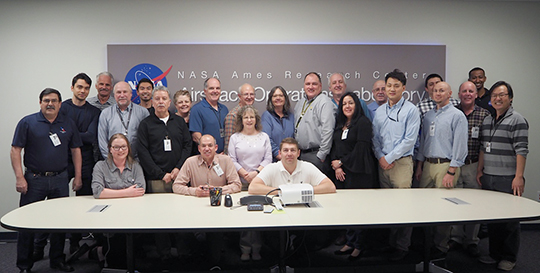
Members of the FAA Flow Evaluation Team (FET), representatives from MITRE Corp. and the AOL IDM team.
Point of Contact: Nancy Smith, M.S., Human Systems Integration Division, NASA Ames Research Center; Paul Lee, Ph.D., Human Systems Integration Division, NASA Ames Research Center
Multi-Sector Planner
The Federal Aviation Administration (FAA) investigated a concept that introduced a new multi-sector planner (MSP) position within air traffic operations. A focal point of the investigation was the determination of roles and responsibilities of the MSP in relation to the current controller and traffic management teams. The AOL worked closely with the FAA in developing, and evaluating technologies, and operational procedures to assess the impact of this new team concept on future airspace operations.
Problem and Prior Research
Air traffic control in the en route airspace environment in the United States (U.S.) had traditionally been performed by a team, consisting of a radar-controller (R-side) and a second controller referred to as a data-controller (D-side) or a radar-associate. Several developments in the technology supporting air traffic management- digital data communication among controllers and between controllers and aircraft, improved positioning accuracy for flight operations, conflict prediction, and sector complexity assessment- have enabled consideration of new organizational structure and functional standards for team operations. One such consideration was a modification of a standard configuration to include a "multi-sector planner" (MSP) position in the team. This MSP position had been investigated in several research and field studies, both in the U.S. and in Europe. The concept provided a spectrum of redistributed roles and responsibilities among the air traffic management team members including physical relocation. The feasibility and effectiveness of two variations of these concepts were investigated initially with the Cognitive Systems Engineering evaluative methodology described in Corker et al (2007).
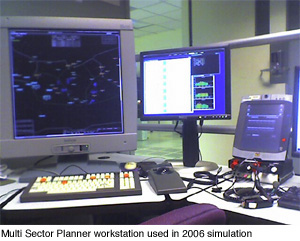 The two concepts for the MSP position that were developed for the FAA in 2005 by researchers from NASA Ames and San Jose State University were: a "Multi-D" concept, where the MSP acts as a D-side controller for several radar controllers, and an "area flow planner" concept. In 2006, a human in the loop (HITL) simulation was conducted to compare both concepts to a baseline condition. Results from this simulation led to selection of the area flow planner concept for further development. The two concepts for the MSP position that were developed for the FAA in 2005 by researchers from NASA Ames and San Jose State University were: a "Multi-D" concept, where the MSP acts as a D-side controller for several radar controllers, and an "area flow planner" concept. In 2006, a human in the loop (HITL) simulation was conducted to compare both concepts to a baseline condition. Results from this simulation led to selection of the area flow planner concept for further development.
The role of the area flow planner MSP, as tested in 2006, was to support the radar controller by planning ahead and smoothing "medium-term" traffic flows for the three sectors within their area of responsibility. Under this concept the MSP had responsibility for managing traffic flows and balancing traffic loads within the multi-sector region of airspace.
While the 2006 simulation demonstrated initial feasibility of the MSP position as an effective member of the air traffic controller team, it was not designed to assess how successfully the MSP could monitor and manage flow problems within his or her own area while also providing assistance to adjacent MSPs. Follow-on research in this area was recommended and is now ongoing, along with the development of communication tools and decision aids, and of appropriate procedures, roles and responsibilities for effective integration of this position within the facility and the NAS.
Follow-up Research
Follow-up research activities continued to build on the results from 2006 and followed the primary recommendations. The objectives included:
(1) Develop procedures for MSP-MSP interactions both within and across facility boundaries. Evaluate impact and feasibility considering that (a) each MSP is actively managing within-area flow responsibilities, while responding to external requests for assistance; and (b) there is an inherent dependency on upstream actions to accomplish local goals. This dependency means that effective collaboration procedures are crucial to the position's success.
(2) Expand the definition of roles, responsibilities, and procedures, integrating the MSPs within the larger context of air traffic control and traffic management operations.
(3) Determine the information and decision support tool the MSP needs for situation assessment, traffic flow manipulation, and for coordination with others (R-sides, D-sides, adjacent MSPs, adjacent and underlying facilities, TMU, and front-line managers).
These objectives were addressed in a series of activities, including: cognitive walkthroughs, simulation shakedown/walkthroughs, and a 4-week HITL evaluation. The objective of the first two walkthroughs was to develop and refine the MSP concept of operations, with particular focus on interactions between the MSP and other positions; the MSP's information and automation support requirements; and identifying research issues and planning the 2009 HITL simulation. Technologies available on the MSP position as well as communication means to facilitate automated interaction with other ATC operators were prototyped by the AOL R&D team based on the 2006 findings and the walkthrough activities described above.
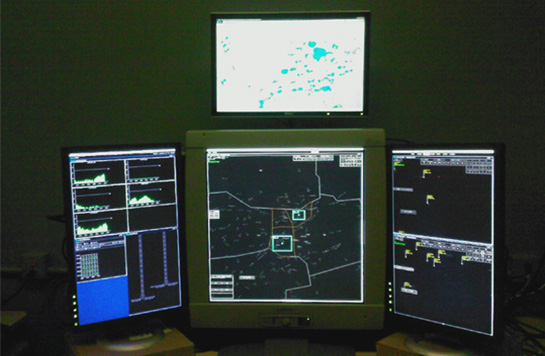
Mock-up of Multi Sector Planner (MSP) workstation for upcoming Human-in-the-Loop simulation in 2009
Publications
K. Corker, D. . Liang, P. U. Lee, & T. . Prevot (2007) New Air Traffic Management Concepts Analysis Methodology: Application to a Multi-Sector Planner in US Airspace, Air Traffic Control Quarterly Vol 15 (4)
T. . Prevot, P. U. Lee, L. . Martin, J. S. Mercer, E. A. Palmer, & N. M. Smith (2006) Tools for Trajectory-Based Air Traffic Control and Multi Sector Planning, HCI-Aero 2006, Seattle, WA, September 2006
Point of Contact: Nancy Smith, Human Systems Integration Division, NASA Ames Research Center
New York Operational Improvements
The New York area airspace is notoriously complex and demanding, and is responsible for a large portion of the delays and congestion in the United States. A new research effort was initiated to examine the chronic problems associated with New York, and to develop integrated NextGen concepts that leveraged existing NASA and other NextGen technologies to reduce delays, increase throughput, and/or improve trajectory efficiencies in this region.
A new research effort called New York Operational Improvements was initiated to address this issue. The research approach has been to develop and refine integrated NextGen trajectory based operations (TBO) that leverage existing NASA and other NextGen technologies to enable precise scheduling and delivery of aircraft along coordinated trajectories. These integrated tools, operations, and procedures focused on specific New York problems that can result in NAS-wide delays and congestion. The NY area presents a rich set of challenges to test the efficacy of new capabilities including excess demand, chronic delays, severe weather, and airspace complexity. Its inefficiencies are of national as well as regional importance, as it accounts for approximately 50% of the NAS-wide delays. Thus NextGen solutions that could alleviate problems in this airspace would provide significant value to stakeholders nation-wide.
The first objective of the research was to learn about the different NY bottlenecks that cause delays and limit capacity. Once the bottlenecks are identified, they can then be tackled, one at a time, by developing an integrated operational concept that addresses each specific problem before evaluating the concept in a human-in-the-loop (HITL) simulation. NY area subject-matter-experts (SMEs) were consulted to identify capacity bottlenecks in the clear weather days to determine the test area and problems that could be addressed. Through this process, a number of potential improvements were identified for the arrival and/or departure problems at the NY airports, as well as the Terminal Radar Approach Control (TRACON) and En Route airspace that feed traffic into these airports.
The problem selected for our initial investigation was that of improving the throughput and efficiency of arrivals inbound for Newark Liberty International (EWR) airport during clear weather, with the test airspace encompassing flows coming from the south through Washington Center (ZDC). An initial HITL simulation in the AOL addressing the New York airspace explored the feasibility of a NextGen TBO solution to address airspace and airport capacity limitations in and around the New York Metroplex. A concept, tools, and operational procedures for improving flight efficiency and runway throughput for EWR arrivals were developed to create a precise, dependent-runway schedule between two intersecting runways. A week-long study, conducted in August 2013, explored the feasibility of a new Optimal Profile Descent (OPD) arrival into the airspace as well as a novel application of the TMA-TM arrival scheduling tool to coordinate high volume arrival traffic to intersecting runways. In the simulation, four en route sector controllers and four TRACON controllers managed traffic inbound to EWR's primary runway, EWR22L, and its intersecting overflow runway, EWR11. TMA-TM was used to generate independent arrival schedules for each runway, while a traffic management coordinator participant adjusted the arrival schedule so that each EWR11 followed a EWR22L aircraft. CMS tools were also provided to assist the TRACON controllers in managing the arrivals descending on OPDs.
The study compared the throughput and safety of an experimental condition labelled Futures using the TMA-TM tools with dependent-runway scheduling, with a Baseline condition that did not. Figure 1 shows the lateral trajectories of the arrivals on OPDs in the Baseline and Futures conditions (5 hours of Baseline and Futures condition runs, with 190 and 198 simulation trajectories, respectively), compared to 24 continuous hours of actual operational data for arrivals from ZDC for EWR22L or EWR11 on a clear weather day (June 27, 2011, 316 aircraft trajectories). The figure illustrates that the OPD RNAV trajectories used in the study resulted in fewer lateral path deviations than the trajectories from the operational data.
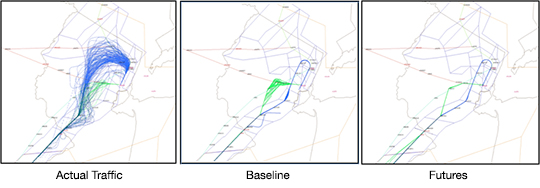
Figure 1: Trajectories from 2011/06/27 operational data (left), Baseline condition (middle) and Futures condition (right).
The results suggested that the efficient RNAV descent procedures were compatible with converging-runway operations using the modified TMA-TM and the controller tools. Further, the combined use of the tools with the new OPDs produced a peak arrival rate of 67 aircraft per hour using instrument flight rules (IFR), exceeding the current maximum arrival rate at EWR of 52 per hour under visual flight rules (VFR). In the Futures condition, the controllers were able to deliver arrival aircraft precisely on OPDs at a high throughput rate for both EWR22L and EWR11 runways with less vectoring, fewer lateral path deviations, and a lower workload. More importantly, a coordinated schedule across the two intersecting runways at a high-throughput rate was successfully managed with minimal coordination using the TMA-TM tools. A coordinated schedule allowed the controllers to deliver their aircraft to the slot markers with the assurance that they would result in conflict-free delivery at the converging runways. The schedule and the slot markers were created taking winds in the account, and therefore the controllers could deliver the aircraft safely even during high wind conditions. In the Baseline condition, the controller needed to make last minute path adjustments on the EWR11 arrivals in order to pair them with the leading EWR22L arrivals, resulting in more lateral path deviations.
In terms of safety, the "go-around" violation data suggested that only the Futures condition could safely increase throughput. The go-around violations were logged whenever the arrivals on EWR11 and EWR22L were spaced too closely to each other during landing. A go-around violation was defined as occurring if the aircraft landing on EWR11 was at its threshold and the aircraft landing on EWR22L had not yet crossed the runway intersection and was less than 1.5 miles out. Figure 21 shows all of the go-around violations that occurred in the study. There were three go-around violation cases observed in the Futures condition, but they were borderline cases that, as identified during a follow-up discussion with a subject-matter expert from EWR tower, in today’s operations would not be considered a violation. Therefore, the go-around violations with safety implications occurred only in the Baseline condition (circled in Figure 2).
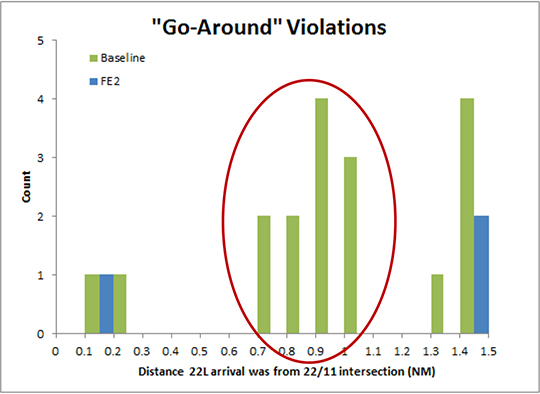
Figure 2: Go-Around Violations.
A follow-up benefit analysis was performed to evaluate the annualized benefit of the increased traffic once the realistic wind and traffic demand were taken into account. The analysis examined the meteorological conditions suitable for using the 11-22L landing runway configuration, and estimated the actual resulting potential for increasing arrival throughput. Aviation System Performance Metrics (ASPM) data were used to determine the traffic demand, runway configurations, meteorological conditions, and wind magnitudes/directions during 2007, 2009 and 2012. The annualized benefit analyses consisted of two parts: (1) identifying the availability of using runway 11 in addition to runway 22L under favorable wind and meteorological conditions beyond the current level of its usage, and (2) applying the increased throughput identified by the simulation study to the 11-22L arrival configuration that can be used across an entire year. Using fairly conservative assumptions about the meteorological conditions, runway usage, and peak demand characteristics, the analysis showed that the 11-22L runway configuration could have been used more than twice as often during high-demand periods (i.e., when arrival demand exceeded throughput), which in turn could have either reduced delays to the impacted aircraft by approximately 15 minutes per aircraft, or increased the overall throughput by approximately 8% - 11% per year. This new operation has the potential to deliver even greater benefits if it were extended to include other runway configurations and demand conditions. The results suggest that a large throughput/delay benefit can be gained from a modest extension of the TMA-TM and make a significant impact in the New York area.
In the years 2014 and beyond, we plan to explore other New York problems and potential solutions that can reduce delays and congestions using integrated NextGen tools, operations, and procedures. In 2014, we are examining ways to reduce departure delays at LaGuardia airport by intelligently scheduling and managing arrival spacing. The study will be conducted in August, 2014.
Points of Contact: Nancy Smith, M.S., Human Systems Integration Division, NASA Ames Research Center; Paul Lee, Ph.D., Human Systems Integration Division, NASA Ames Research Center
OASIS
The Operational Airspace Sectorization Integrated System (OASIS) tool assisted Area Supervisors in their planning of sector combine/decombine operations as well as opening/closing of Data-side (D-side) control positions. These advisory solutions were tailored to the predicted traffic demand over a period of 3-4 hours.
Dynamic Airspace Configuration (DAC) was a new operational paradigm that proposed to migrate from the current structured, static airspace to a dynamic airspace capable of adapting to user demand while meeting changing constraints of weather, traffic congestion and complexity, as well as a highly diverse aircraft fleet.
DAC research consisted of three major components: 1) the overall organization of the airspace; 2) dynamically changing airspace to meet the demand; and 3) a generic airspace characterization. The first component related to a strategic organization of airspace and the creation of new classes of airspace to take advantage of concepts and technologies that were expected to be available by 2025. The second component relates to the dynamic airspace reconfiguration that was needed to accommodate a fluctuating demand. The third component related to "generic" airspace designs that could promote interchangeability among facilities and controllers by removing structural and functional components of the airspace that would require site-specific training of the airspace.
Problem
The National Airspace System (NAS) is an interconnected system of airports, air traffic facilities, equipment, navigation aids, and airways. Airspace design engineers and air transportation policy makers are continually adjusting system parameters in an attempt to anticipate changes in system demand that result as a consequence of foreseen (e.g. time of day) and unforeseen factors (e.g. weather systems that disrupt the NAS), or because of changes in air traffic management (ATM) policies that govern the operations in the NAS. One key element in guiding the safe and efficient operations of the NAS is airspace management. Airspace management requires predicting the load that is being placed and the capacity possible in the NAS. The current NAS architecture is reaching the limits of its ability to accommodate increases in traffic demand.
An essential element of the NAS transformation is to use more efficient allocation of airspace as a capacity management technique. The NextGen concept calls for a future system in which daily operations are managed with four-dimensional (4D) aircraft trajectories while the airspace structure and controller resources are continually adjusted to meet user needs. The airspace structural adjustments needed to manage traffic demands and capacity issues are being examined at NASA as part of a set of research activities called Dynamic Airspace Configuration (DAC) under the NGATS ATM-Airspace project.
Prior Research
In 2007 to 2008, we were engaged in two activities in support of the initial stages of DAC research. The first activity involved documenting current state-of-the-art on the airspace design and configuration practices in order to provide a baseline from which the future system can improve upon. The second activity was a human-in-the-loop simulation on the effects of mixed equipage on airspace configuration.
Examination of Current Airspace Structural Components and Configuration Practices
To understand how the air traffic system can transform from the existing airspace structures and operational practices to what is envisioned in the NextGen operations, we cataloged DAC-relevant airspace components and operations used in the present day, as well as research and near-term operational implementations that are currently being pursued. Dynamic airspace reconfiguration in operations at the time had limited options in terms of how sectors and airspace can be reconfigured due to various technological and human factors issues. DAC envisions the future sectors to be substantially more dynamic, changing fluidly with the changes in traffic, weather, and resource demands.
Effects of Mixed Operations on Airspace Configuration
Future airspace configuration is largely uncharted and one of the most interesting areas of research. As the new concepts such as automated separation assurance (e.g. automation detects and resolves conflicts between aircraft that meet minimum equipage requirement) evolve, the airspace must be designed and configured to support them. One of key assumptions that need to be defined before designing new airspace configuration methodologies is to determine whether the future airspace should be segregated or integrated. Segregated (also known as exclusionary) airspace refers to that airspace which only allows aircraft that are supported by either ground-based or air-borne separation management automation. Integrated (also known as non-exclusionary) airspace refers to that airspace which allows both types of aircraft, aircraft that are supported by separation management automation and aircraft that are not supported by such automation. Under the segregated airspace operations where the automation is responsible for conflict detection and resolution; the role of controller is largely confined to monitoring, if deemed useful, under normal operations. Under the integrated airspace operations the automation is responsible for conflict detection of all aircraft and resolution of aircraft that are equipped or capable of being supported by such automation whereas the controller is responsible for conflict resolution of aircraft that are not equipped to support the automated separation.
An experiment was conducted to investigate the effects of Mixed Operations on Airspace Configuration. A general hypothesis of the study was that mixed equipage operations would be feasible during moderate traffic levels for both the unequipped aircraft that the controllers needed to control and the total number of aircraft in the sector. It was also hypothesized that there exists a certain critical airspace complexity threshold that once exceeded would make the mixed operations infeasible. In order to explore the effects of traffic densities and the associated airspace complexity, the experiment varied two traffic factors, namely the traffic levels of unequipped and the equipped aircraft.
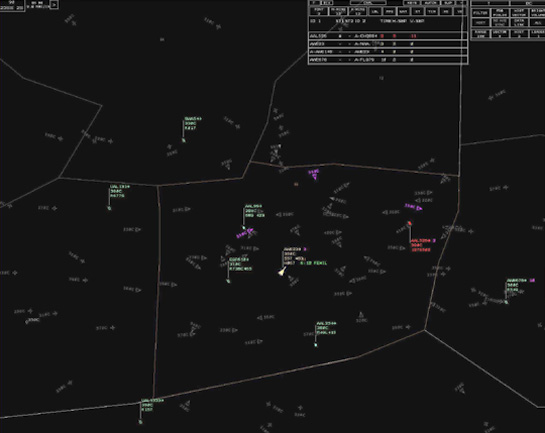
Controller display with equipped (dim limited datablock) and unequipped (colored full datablock) aircraft in mixed separation-assurance airspace
Follow-up Research
A human-in-the-loop simulation study was conducted in 2009 to examine the limits of the number and the types of changes in the airspace that the controllers can handle in dynamic airspace reconfiguration of future operations. Some of the interesting variables that may affect the ability of the controllers to adapt to airspace changes include:
- Boundary change methodology- airspace boundaries can change instantaneously from one sector configuration to another, or they can "morph" incrementally
- Rapidity of changes- how often can the boundaries be changed before exceeding controllers' cognitive capability to adapt
- Level of traffic complexity at the boundary change- e.g. number of climbing/descending aircraft, complexity of merge points, etc.
- Number of variables that change at the boundary change- e.g. changes in route structures, radio frequencies, area of responsibility (e.g. change in controlled airspace altogether), etc.
- Amount of coordination and/or training required prior to the airspace change
- Assumptions about decision support tools and separation responsibilities- e.g. automation support for transfer-of-communication, conflict detection, conflict resolution, etc.
A team of researchers- consisting of algorithm developers who were researching ways to optimally change airspace boundaries, operational experts who understood trigger events that lead to airspace changes in current operations, and human factors researchers - worked together to explore the impact of dynamic airspace changes on the controllers and the feasible limits of the changes that are possible in the future airspace.
 Download the full Dynamic Airspace Configuration Synopsis (PDF - 612KB) Download the full Dynamic Airspace Configuration Synopsis (PDF - 612KB)
 Download Adobe Acrobat Reader Download Adobe Acrobat Reader
Publications
Boetig, R.C., Borowski, M., & Wendling V.S. (2004). ZOA HAR design and Q Route validation, MP04W0000236, The MITRE Corporation, McLean, VA.
Doble, N.A., Hoffman, R., Lee, P.U., Mercer, J., Gore, B., Smith, N., & Lee, K. (2008). Current Airspace Configruation Practices and their Implications for Future Airspace Concepts, AIAA 8th Aviation Technology Integration Operations Seminar, Anchorage, AK.
Lee, P.U., Mercer, J., Gore, B., Smith, N., Lee, K., & Hoffman, R. (2008). Examining Airspace Structural Components and Configruation Practices for Dynamic Airspace Configuration, AIAA Guidance, Navigation, and Control Conference and Exhibit 18 - 21 August 2008, Honolulu, HI.
Kopardekar, P., Bilimoria, K., & Sridhar, B. (2007). Initial concepts for Dynamic Airspace Configuration, 7th Aviation Technology, Integration and Operations (ATIO) Seminar.AIAA, Belfast, Northern Ireland.
Point of Contact: Paul Lee, Ph.D, San Jose State University/NASA Ames Research Center
SOAR
This research focused on how to support air traffic controllers in safely and efficiently managing arriving and departing aircraft that are flying in shared airspace.
In metroplex environments, efficiency and delays can be further compromised by the density and complexity of operations. A metroplex is defined by the Joint Planning and Development Office (JPDO) as an area with high traffic demand served by two or more airports with arrival and departure operations that are highly interdependent. Metroplex interdependencies stem from different traffic flows sharing common fixes, paths or airspace volumes within the metroplex airspace.
Terminal area flows often compete for the same airspace resources. Today, high-priority flows are given efficient procedures through the airspace, while lower-priority flows are given less efficient procedures in the remaining airspace. Examples are when departure flows tunnel under arrival streams or when a major airport arrival stream forces satellite airport arrivals or departures to fly extra distance to avoid using the same airspace. These are examples of spatial or procedural separation. The other common means of separating aircraft is with temporal separation. First, one aircraft uses the airspace, and then another. Temporal separation is currently used to separate aircraft where flows merge at arrival meter fixes or runways. Scheduling can be used to make temporal separation more efficient. Schedulers for arrival traffic like the Traffic Management Advisor (TMA) are based on predictions of when aircraft in multiple flows will reach merge points.
Several studies on operations in metroplex environments have explored trajectory-based scheduling and temporal separation to applications where flows of arriving and departing aircraft from multiple airports cross each other. Optimization problems indicate that being able to dynamically use either or both spatial or temporal separation results in the most efficient operations.
The objective of this project was to explore operational issues of managing metroplex operations with either spatially or temporally shared terminal airspace resources such as, route segments, fixes and runways. Our approach was to pick a potential shared airspace problem where spatial separation is currently used and to develop a new operational concept where either spatial or temporal separation was used and then evaluate the procedures and controller tools in a Human-In-The-Loop simulation.
Our operational concept was based on the use of advanced scheduling and spacing tools to identify and display gaps in an arrival flow that could be used by aircraft on an optimized departure route that crosses the arrival flow. The airport tower has a timeline schedule that shows when departing aircraft on the optimized route should depart in order to cross gaps in the arrival flow (see picture of timeline below). The departure route is also designed to fly on a procedural route that is vertically separated from arrival aircraft in the off-nominal case where lateral separation with the arrival aircraft was not adequate. Terminal Radar Approach Control controllers use point-out or pre-arranged coordination procedures to coordinate the departures to climb through arrival airspace.
Decision support tools were explored to improve the safety of the controllers’ decision to climb departure aircraft through arrival airspace. We are looking into using depiction of arrival and departure aircraft’s positions on timeline and on the radar scope. We were interested in using static or dynamic tools to predicting conflicts between arrival and departure aircraft. We were also interested in developing a tool that resolved departure trajectories that were conflicting and suggested new trajectories that can be used to safely cross arrival traffic. Examples of tools were: tie-box markings, conflict probe, ghosting position, slot markers, and trajectory resolution and scheduling.
Underneath is an example of tie-boxes. Tie boxes are static tools used to predict the loss of separation of two aircraft flying to a same waypoint. It uses a reference point for one aircraft and checks the relative positions of other aircraft. If some other aircraft are inside a tie-box, it means that the relative aircraft will likely be less than 4 miles away from the referenced aircraft when it crosses the shared waypoint.
Another example is a conflict probing tool. The tool is a dynamic tool that predicts whether a loss of separation for a given aircraft can be anticipated with other surrounding aircraft. It computes the trajectories and predicts the separation for converging trajectories. The tool can be set to be an alert or can be set to be used at the controller’s discretion.
Other shared airspace configurations were also explored. For instance, scheduling and merging departure aircraft from two airports that go over the same waypoint.
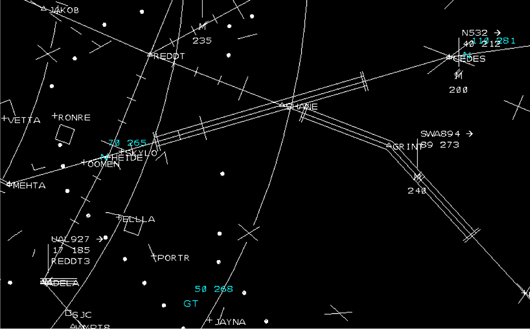
Example of tie-boxes
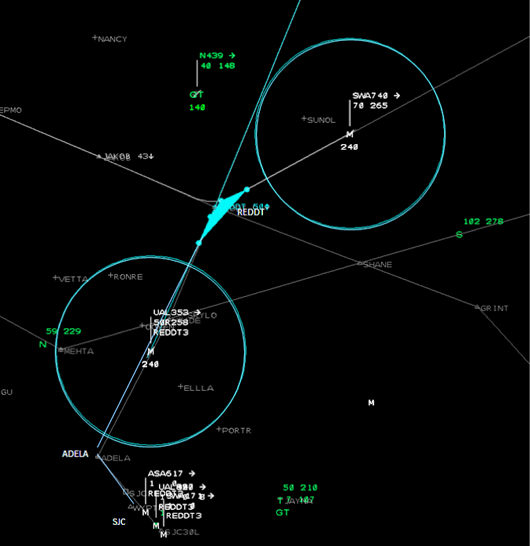
Conflict probe between departure and arrival aircraft
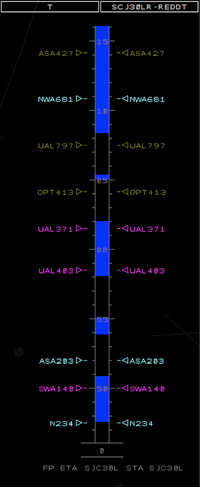
Example of timeline at the runway with predicted gaps in arrival stream and departures in magenta that are scheduled to cross gaps
Reference:
Chevalley, E., B. Parke, P. Lee, F. Omar, H. Lee, N. Bienert, J. Kraut, E. Palmer, 2013, Scheduling and separating Departures crossing arrival flows in shared airspace, Proceedings of the 32nd the Digital Avionics Systems Conference, Syracuse, NY.
Points of Contact: Everett Palmer, Ph.D., Human Systems Integration Division, NASA Ames Research Center
Unmanned Aircraft System (UAS) Traffic Management (UTM)
In collaboration with industry leaders, academia, and government groups, the AOL, responsible for the simulations and human/system integration research focus areas, played a vital role in developing requirements needed to safely and efficiently integrate low-altitude UAS operations into the NAS. Various extensions of the AOL's UTM work are currently being pursued in other projects such as Scalable Traffic Management for Emergency Response Operations (STEReO) and Federal UAS Service Supplier (FUSS).
Both of the UTM-TCL4 technical reports have been released and can be seen by clicking the following links.
- TCL4 UTM (UAS Traffic Management) Texas 2019 Flight Tests, Airspace Operations Laboratory (AOL) Report
- TCL4 UTM (UAS Traffic Management) Nevada 2019 Flight Tests, Airspace Operations Laboratory (AOL) Report
The following paper by members of the Airspace Operations Lab was awarded Best Paper of Track, Session, and Conference at the 39th Digital Avionics Systems Conference.
- Wolter, C., Martin, L., & Jobe, K., 2020, Human-system interaction issues and proposed solutions to successful maturation of the UTM system, Proceedings of the 39th Digital Avionics Systems Conference (DASC). October 13-16, 2020, San Antonio, TX
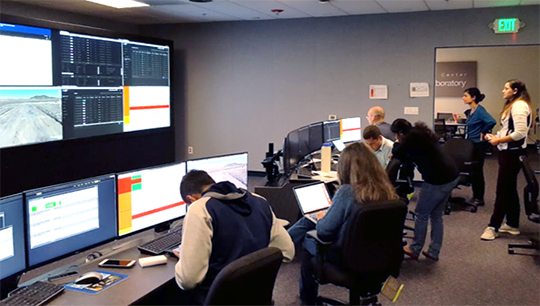
A typical day in the AOL during the UTM Technical Capability Level 3 (TCL3) demonstration
Long before stories of Unmanned Aircraft Systems (UAS), commonly known as "drones," were frequent in the news, NASA and the Federal Aviation Administration (FAA) recognized the need for a way to safely manage UAS flying at low altitudes in airspace not currently managed by the Federal Aviation Administration (FAA).
With innovators constantly identifying new, beneficial applications for UAS - goods delivery, infrastructure inspection, search and rescue, agricultural monitoring - a set of robust procedures and increasingly automated services was required, that provided an effective and efficient operational environment for UAS, maintained an adequate level of safety for the flying and non-flying public, and did not require a high degree of human oversight or interaction.
Building on its legacy of work in air traffic management for crewed aircraft, NASA researched prototype technologies such as airspace design, dynamic geofencing, congestion management and terrain avoidance for a UAS Traffic Management (UTM) system that could enable safe, efficient low-altitude operations.
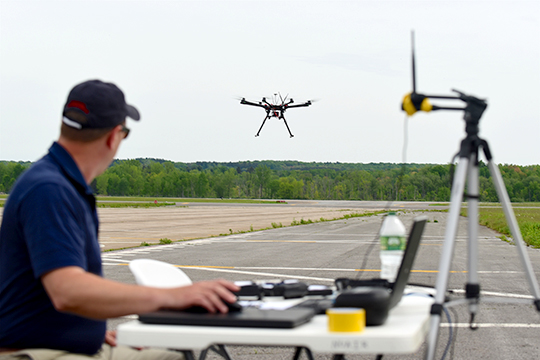
A New York test site pilot launches his drone on another planned maneuver. Credits: NUAIR Alliance / Eric Miller
For more than 25 years, NASA AOL has conducted air traffic management system research, often collaborating with the FAA, providing a variety of computer-based tools that helped improve flight efficiency, reduce delays, and reduce fuel use and emissions all while maintaining safety in increasingly crowded skies.
NASA's Ames Research Center, with
its extensive experience in autonomous systems and air
traffic management, led the UTM research in close collaboration with NASA's Armstrong Flight Research Center, NASA's Glenn Research Center and NASA's Langley Research Center. Ames has a history of conducting research in autonomy-related topics, and is experienced at developing systems that can adapt their behavior to environments that are complex, rapidly changing and incompletely understood.
Points of Contact: Jeffrey Homola, M.S., Human Systems Integration Division, NASA Ames Research Center, Joey Mercer, M.S., Human Systems Integration Division, NASA Ames Research Center |
|
|